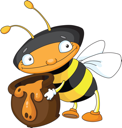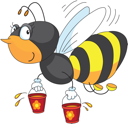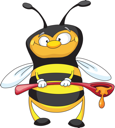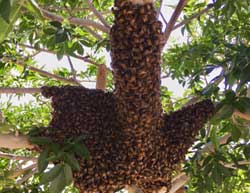Fun Facts
 Did you know? Honey bee workers visit flowers to collect nectar and pollen. During the transport to the hive, pollen is held in a structure on each hind leg called the “Pollen Basket” and nectar is carried in a structure in front part of the digestive system, called the “Honey Sac”.
Did you know? Honey bee workers visit flowers to collect nectar and pollen. During the transport to the hive, pollen is held in a structure on each hind leg called the “Pollen Basket” and nectar is carried in a structure in front part of the digestive system, called the “Honey Sac”.
Did you know? Worker bees communicate with other worker bees, conveying information about the type of nearby nectar source, distance and direction from the  hive “Using Dances”.
hive “Using Dances”.
Did you know? Swarm of bees come from old hives, the old queen lays three fertilized eggs and one of this three fertilized eggs will become the new queen. And the old queen will take with her the necessary amount of worker bees to search (Bee Swarm) for a new home and to start a new bee colony/bee hive.
Did you know? A honey bee can flap it’s wings approximately 230 beats per second, or 13,800 per minute.
Did you know? There are about 20,000 different species of bees in the world. Bees live in colonies and there are three types of bees in each colony. There is the queen bee, the worker bee and the drone. The worker bee and the queen bee are both female, but only the queen bee can reproduce. All drones are male. Worker bees clean the hive, collecting pollen and nectar to feed the colony and they take care of the offspring. The drone’s only job is to mate with the queen. The queen’s only job is to lay eggs.
 Did you know? Bees store their venom in a sac attached to their stinger and only female bees sting. That is because the stinger, called an ovipositor, is part of the female bee’s reproductive design. A queen bee uses her ovipositor to lay eggs as well as sting. Sterile females, also called worker bees, don’t lay eggs. They just use their ovipositors to sting.
Did you know? Bees store their venom in a sac attached to their stinger and only female bees sting. That is because the stinger, called an ovipositor, is part of the female bee’s reproductive design. A queen bee uses her ovipositor to lay eggs as well as sting. Sterile females, also called worker bees, don’t lay eggs. They just use their ovipositors to sting.
Did you know? Bees see all colors except the color red. That and their sense of smell help them find the flowers they need to collect pollen. Not only is pollen a food source for bees, but some of the pollen is dropped in flight, resulting in cross pollination. The relationship between the plant and the insect is called symbiosis.
Did you know? Certain species of bees die after stinging because their stingers, which are attached to their abdomen, have little barbs or hooks on them. When this type of bee tries to fly away after stinging something, part of the abdomen is ripped away.
Need A Swarm Removed?
Live Support Chat?




